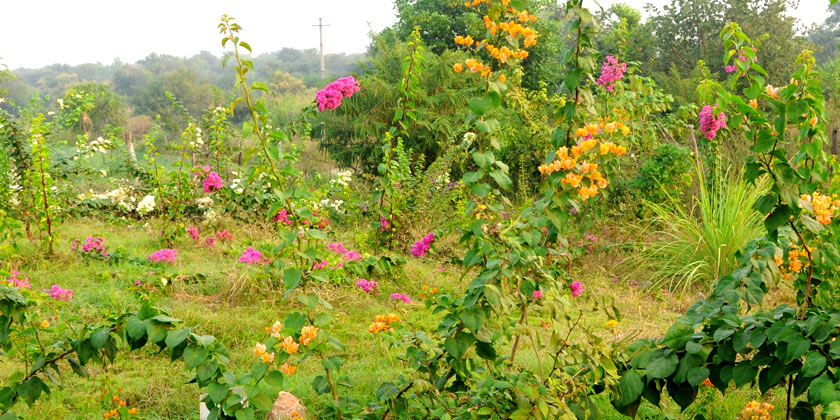Aravalli Biodiversity Park
Biodiversity profile
Mammals
The ecologically diverse niches found within different plant communities enriched animal communities. The most common mammalian species found in the biotic communities are Jackal, blue bull, mongoose, porcupine, Indian hare, palm civet and bats. These mammals are presented by large populations.
Avifauna
The Aravalli Biodiversity Park is home to variety of birds because the habitat of ABP has diverse microclimatic conditions coupled with rich food base. More than 190 species have been sighted in ABP. The most prominent ones are: Babblers, Barbets, Bee-eaters, Cuckoos, Bulbuls, Peafowl, Drongos, Flycatchers, Warblers, Parakeets, Munias, Partridges, Woodpeckers etc. In winter many migratory species such as Verditer flycatcher, Red throated flycatcher, Himalayan warblers, Peregrine falcon can be spotted here. Indian pitta (rare for Delhi) can also be seen here.
Amphibians and Reptiles The enhanced moisture levels coupled with thick leaf litter on the forest floor and availability of water in mining pits greatly contributed in the enrichment of amphibians and reptiles. A total of 29 species are encountered in ABP. The most common ones are: Common Indian toad, Skittering frog, Indian flapshelled turtle, Indian cobra, Common Indian krait, Saw scaled viper, Royal rat snake, Shaw’s wolf snake, Red sand boa, Common sand boa etc.
Among lizards, Indian monitor lizard, Fan throated lizard and Striped grass skink are common. Leopard gecko is found only in ABP and it is reported for the first time from Delhi.
Insects' diversity Insects are by far the most common type and most populous animal on the planet. Insects play a major role in the pollination of flowers, and also food base for many animals at some stage of their life. In fact, there are many plants that depend entirely on insects for pollination. Park includes a wide variety of insects which vary seasonally. There are more than 20 insects orders found in ABP, some them are mentioned below:
Hemiptera: bugs, water striders
Homoptera: cicadas
Hymenoptera: ants, bees, wasps
Lepidoptera: butterflies, moths
Orthoptera: crickets, grasshoppers
Araneae: spiders
Isoptera: termites
Coleoptera: fireflies. beetles
Odonata: dragonflies, damselflies
Flowering plants

Aravalli Biodiversity Park has diverse landscape such as deep pits of varying depth and length, central flat land with small and shallow depressions, ridge type land with broad undulations with gentle to steep slope. This variation in landscape support wide range of plant communities ranging from grasslands, shrub land, and tropical thorn forest to broad-leaved deciduous forests. Wild native flowers yield a kaleidoscope of colours and forms as they bloom and fruits in different forest communities of the park.
Mammals
The ecologically diverse niches found within different plant communities enriched animal communities. The most common mammalian species found in the biotic communities are Jackal, blue bull, mongoose, porcupine, Indian hare, palm civet and bats. These mammals are presented by large populations.
Avifauna
The Aravalli Biodiversity Park is home to variety of birds because the habitat of ABP has diverse microclimatic conditions coupled with rich food base. More than 190 species have been sighted in ABP. The most prominent ones are: Babblers, Barbets, Bee-eaters, Cuckoos, Bulbuls, Peafowl, Drongos, Flycatchers, Warblers, Parakeets, Munias, Partridges, Woodpeckers etc. In winter many migratory species such as Verditer flycatcher, Red throated flycatcher, Himalayan warblers, Peregrine falcon can be spotted here. Indian pitta (rare for Delhi) can also be seen here.
Amphibians and Reptiles The enhanced moisture levels coupled with thick leaf litter on the forest floor and availability of water in mining pits greatly contributed in the enrichment of amphibians and reptiles. A total of 29 species are encountered in ABP. The most common ones are: Common Indian toad, Skittering frog, Indian flapshelled turtle, Indian cobra, Common Indian krait, Saw scaled viper, Royal rat snake, Shaw’s wolf snake, Red sand boa, Common sand boa etc.
Among lizards, Indian monitor lizard, Fan throated lizard and Striped grass skink are common. Leopard gecko is found only in ABP and it is reported for the first time from Delhi.
Insects' diversity Insects are by far the most common type and most populous animal on the planet. Insects play a major role in the pollination of flowers, and also food base for many animals at some stage of their life. In fact, there are many plants that depend entirely on insects for pollination. Park includes a wide variety of insects which vary seasonally. There are more than 20 insects orders found in ABP, some them are mentioned below:
Hemiptera: bugs, water striders
Homoptera: cicadas
Hymenoptera: ants, bees, wasps
Lepidoptera: butterflies, moths
Orthoptera: crickets, grasshoppers
Araneae: spiders
Isoptera: termites
Coleoptera: fireflies. beetles
Odonata: dragonflies, damselflies
Flowering plants

Aravalli Biodiversity Park has diverse landscape such as deep pits of varying depth and length, central flat land with small and shallow depressions, ridge type land with broad undulations with gentle to steep slope. This variation in landscape support wide range of plant communities ranging from grasslands, shrub land, and tropical thorn forest to broad-leaved deciduous forests. Wild native flowers yield a kaleidoscope of colours and forms as they bloom and fruits in different forest communities of the park.









